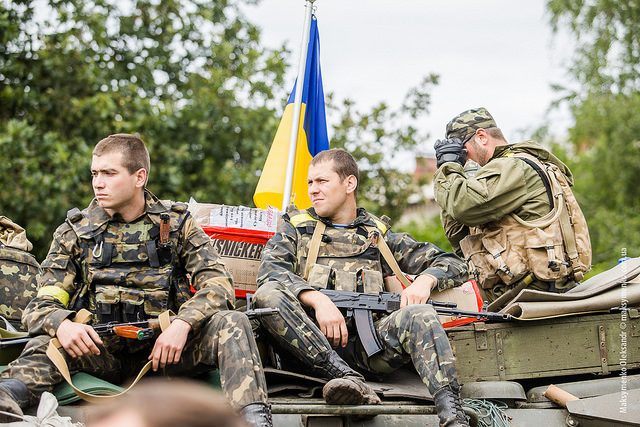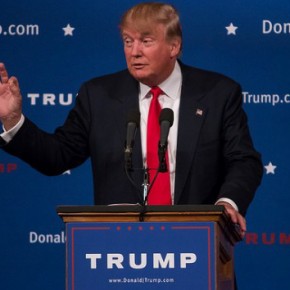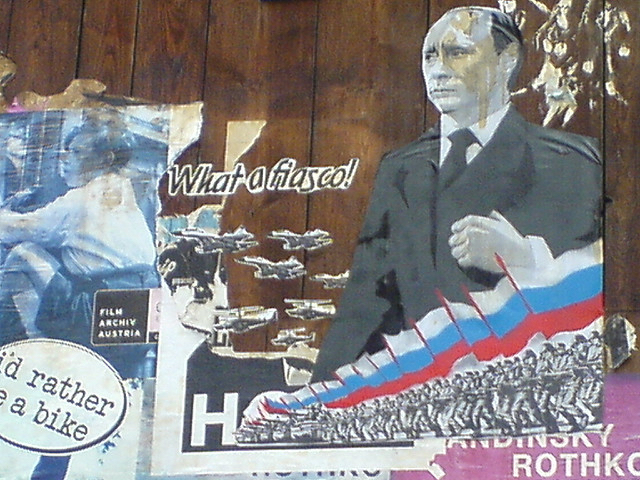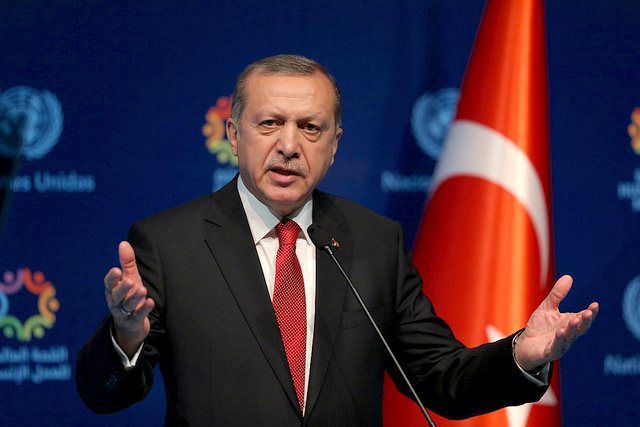Beginning in April 2013, armed bands of locals in the Luhansk and Donetsk oblasts declared their independence from the Ukrainian state. This followed a similar uprising in Crimea that was directly supported by elements of the Russian security services and ultimately led to the annexation of the Crimea to the Russian Federation.
It was a course of action few analysts or politicians, even in Russia, had foreseen. Roy Allison, writing in 2008, noted that a Russian-sponsored revolt in Crimea to resolve the Black Sea Fleet basing question once and for all was unlikely because “Moscow’s effort to influence the strategic course of Ukraine’s foreign policy and its approach to NATO is more easily pursued by working on politicians in Kiev and playing on Ukraine’s persistent inability to sustain firm ruling coalitions”.
Likewise, Tetyana Malyarenko and David J. Galbreath argued in 2013 – before the “Euromaidan” movement took form – that “the geopolitical context means that neither Ukraine nor Russia have an interest in changing the status quo” there.
Just months later, though, Moscow chose to abandon this policy in order to directly annex Crimea to the Russian Federation. It dispatched soldiers to occupy the peninsula’s military sites, and this empowered local separatists to hold a referendum that “legitimized” annexation. It is debatable to what extent the seizure was planned in advance – that is, to what extent contingency plans already in existence to seize the peninsula were activated before or during the final days of the Yanukovych government – or was the result of an ad hoc plan to derail the efforts of Ukraine’s new government to consolidate control of the country’s minority Russian areas that did not welcome the new order.
Most likely, it was a combination of both. A contingency plan existed, but the Russian government acted on it in haste without truly considering the costs of the undertaking, which compelled the Russian Federation to go “all-in.”
Indeed, the initial Russian intervention in Crimea mirrored actions taken against Georgia during the 1990s, when Russia could have but did not openly attempt to annex Georgian territories. During that period, Georgian nationalists had repudiated the constitution of the former Soviet republic, and then also repudiated autonomy provisions for the enclaves of Abkhazia and South Ossetia guaranteed under that constitution.
The enclaves’ non-Georgian population, of course, resisted centralization and attempts by the Georgian state to enforce its rule. This led to armed conflict, which the separatists won with tacit (and not-so-tacit) Russian backing. They then began expelling ethnic Georgians from these territories, despite (or perhaps, because of) the Russian peacekeeping mission’s presence in the region.

Before the 2008 war, Russian interventions were carried out discreetly in favor of the separatists. These interventions were justified in the name of humanitarian protection of Russian-speaking minorities and to prevent further destabilization in the region – which was not altogether untrue given that Moscow could not fully control the separatists’ popular agenda. This stood in contrast to what happened in the Crimea, where the use of force and general apathy of the population towards the post-Yanukovych government(s) made it easier to stage manage the annexation.
In the lead-up to the 2008 conflict, Russian foreign policy had been dealt a setback over the recognition of Kosovo – recognition that was seen as hypocritical and threatening to Moscow given the Western condemnation of Russian support South Ossetia and Abkhazia. Combined with more assertive Georgian policies, especially the government’s NATO aspirations, against Russian pressure, the Kosovar issue crossed a redline (and would, in 2014, be cited by Vladimir Putin in defense of the Crimean matter).
The Russian military escalated its covert support of anti-Georgian separatists and began implementing contingency plans for an invasion of Georgia proper. This too mirrored events in Ukraine – the “redline” in this case being the association agreement with the EU, which was joined to the question of whether the interim Turchynov government would modify the highly contested 2012 language law to downgrade the Russian language’s official status.
It is worth noting that during this period, local associations in Crimea and southeastern Ukraine passed resolutions in support of Russia and South Ossetia against Georgian “aggression”, while the government in Kiev at the time took the opposite position due to fears it would encourage these local separatists.
This, initially, seemed to be the policy for Crimea. When the interim Ukrainian government sought to suppress separatist agitation on the peninsula, some anti-Euromaidan politicians appealed to the Russian Federation to intervene. Russian forces then did so, aided by local collaborators who went on to the Donbas thereafter – and became much harder to stage manage since local support for separatism was stronger than in the Crimea.
Here, though, is where Russia went beyond even its 2008 “small war” against Tbilisi. Russia did not follow its victory over Georgia by annexing South Ossetia, settling for de facto independence – a move that was not without controversy among Russian policymakers who thought the Kremlin could have gotten by back then without recognition of the breakaway territories. This is also the case in nearby ex-Georgian Abkhazia, and further afield in Transnistria on the Moldova-Ukraine border – both regions separated from their former Soviet republics with Russian backing in the 1990s.
No annexation followed their breaks from central control: Moldova, because of its distance from Russia proper and Ukraine’s Donbas because annexation would qualify as a policy failure, since it would constitute admitting Russia’s role there and taking on Donbas’ many economic problems. But Russia did follow up in the Crimea by annexing the peninsula on March 21, 2014.

The local separatists’ rationale for the impending Ukrainian crackdown had been a referendum for autonomy: under Russian occupation, that change into a referendum on annexation, which led to the eventual proclamation of Sergey Aksyonov, a local separatist politician, as the “Prime Minister” of Russia’s newest federal subject. De jure annexation followed, under a new law specially introduced to the Duma to allow Crimea’s ascension to the Russian Federation.
“The open use of forces — often under the guise of peacekeeping and crisis regulation”, wrote the chief of the Russian Army’s general staff in February 2013, would in future conflict go together with “the use of special-operations forces and internal opposition to create a permanently operating front through the entire territory of the enemy state, as well as informational actions” to achieve a decisive moment in Russia’s favor against “manufactured” uprisings threatening regional stability.
As Mark Galeotti, who has provided an annotated a copy of this military treatise, notes, this is the formula now being pursued by Russia in Ukraine to cleave Donbas off from the rest of the country. Because this model is low-cost in terms of securing domestic military and political capital, deterring it in the Russian near abroad has to date been entirely unsuccessful, outside of the three Baltic States, which enjoy NATO membership.
Ironically, the Ukrainian law regulating trade with and entry into occupied Crimea is actually based on a similar Georgian law governing relations with Abkhazia and South Ossetia. A law, incidentally, enacted by the current governor of Odessa, Ukraine: Mikheil Saakashvili, who in 2008 was President of Georgia. Of course, his experience with those regions is largely why he was invited to Ukraine.
The international community’s commitment to Ukraine’s territorial integrity can be measured against their desire to resume “business as usual” with the Russian Federation. This has been the case with “frozen conflicts” in Georgia and Moldova that drew much censure of Russia from the European community, but few punitive measures. That these governments would like to resume normal activities and ties is understandable, but it is an impediment to conflict resolution because it biases the process against Ukraine.
The EU is in the position of having to justify short-term costs caused by cutting ties with Russia in the name of long-term goals to reduce European integration with Russia. While pursuing such a long-term policy would harm Russia far more than the EU, because Russian leaders need European capital far more than EU energy companies need Russian energy exports, selling de-integration means undoing many cozy relationships that politicians, bankers, and importers have developed with Russian enterprises.
Unlike the former Georgian territories, which Moscow is reluctant to formally annex, Crimea was of sufficient strategic value to risk the international fallout. Crimea was different, though as in 2008 with respect to South Ossetia, Russian officials have gone on the record with such statements – they will not allow Kiev to roll-up the people’s republics – in Donbas (though, at the same time, they insist they have nothing to do with the fighting going on there). In Russia, no serious political actor will go on the record saying s/he would now change Crimea’s status in the Russian Federation, let alone return it to Ukrainian rule, even to negotiate a comprehensive peace deal with Kiev.
While it was a major break in Russian foreign policy, the government (correctly) assessed that the short-term consequences would be limited: Europe, which had been busy doing business with Moscow for the past decade, was loathe to break off relations and forfeit lucrative contracts. Despite the censure Russia drew in 2008 over the war with Georgia, it was not expelled from any bodies of note, nor sanctioned in significant ways.
Indeed, it accomplished an additional objective: Russia destabilized Georgia enough that Georgia’s possible membership in NATO was mooted by that very organization on the grounds that Georgia had become unstable. Russian actions in Ukraine have ensured this same dynamic will continue to prevail in Kiev’s case.
Photographs courtesy of Sasha Maksymenko, Jim Forest, and Nicolae Pojoga. Published under a Creative Commons license.





